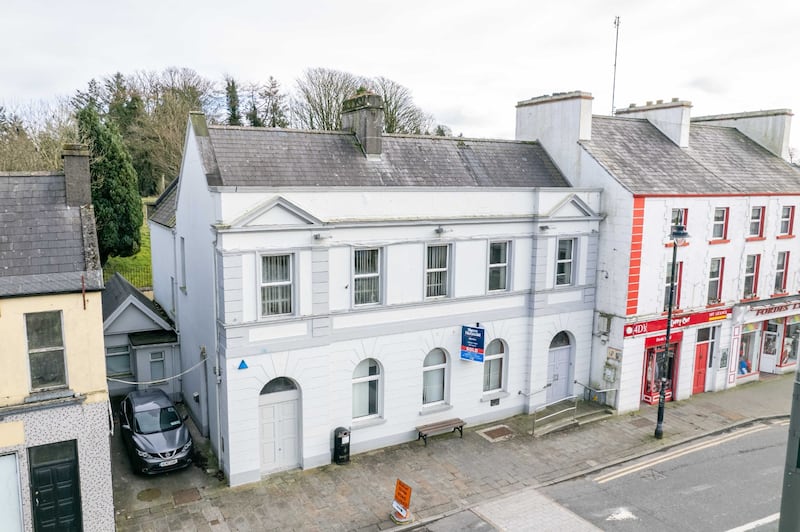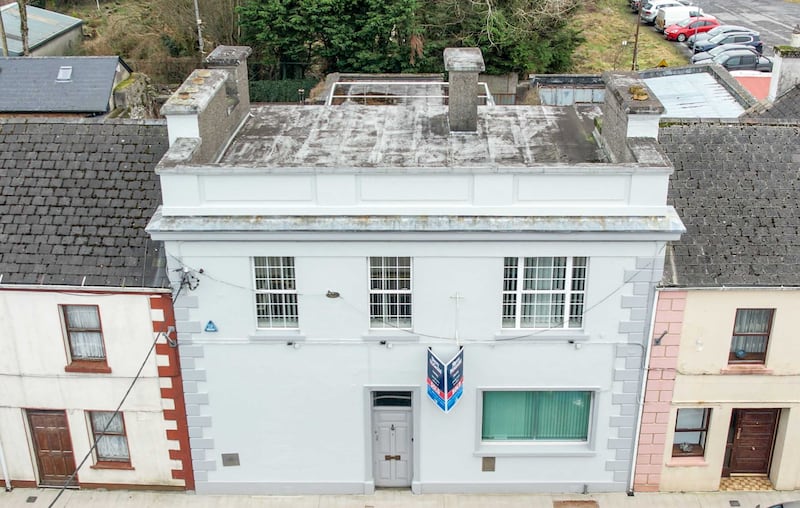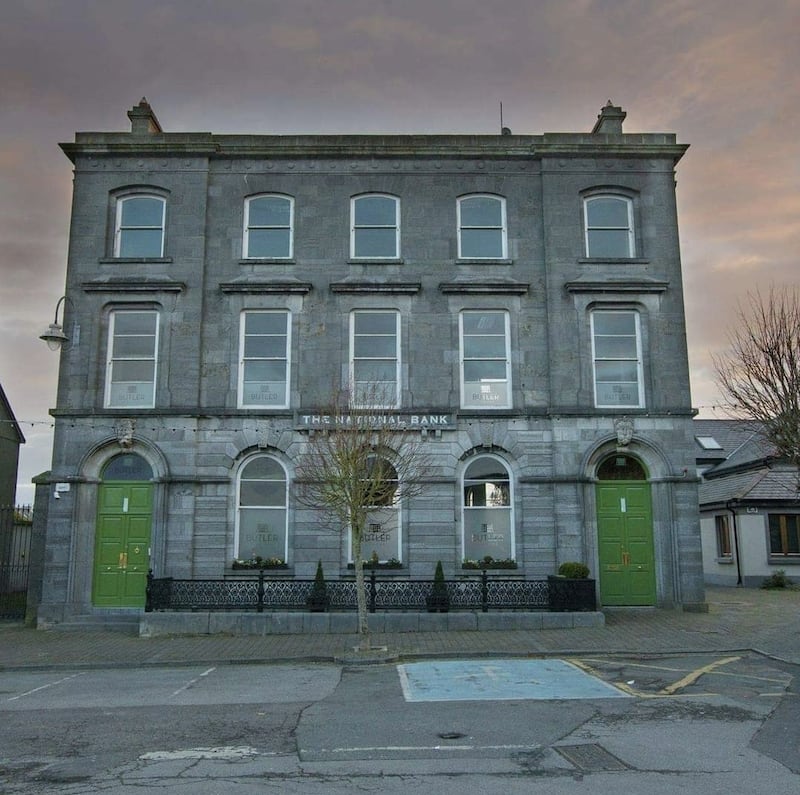If you’re in search of a home with a history, then talk to your bank. The way things have been going with banking, they may well be selling a branch. For a well-maintained, secure building with period features in a central location, one of the many former bank buildings now up for sale could be a steal.
Over the past five years, some 176 bank branches around the country have closed with many services migrating online as banks have sought to lower costs, or, in the case of Ulster Bank and KBC, quit the country. The largest number of bank buildings closed between 2021 and 2023, with the closure of multiple Bank of Ireland and Ulster Bank branches.
Once upon a time, imposing facades, high ceilings, marble columns, decorative floor tiles, mahogany stairs and ornate ceiling roses were how banks impressed customers and reassured them their money was in safe hands. Now, most things once done in a bank branch have moved online. Customers are grateful for a timely callback or a non-glitchy app. Banks’ period features, however, can contribute to them becoming unique and attractive homes.
[ Bank closures in Ireland: how the closure of 176 branches was mappedOpens in new window ]
Former banks are on the list of vacant commercial properties which, under the Government’s Housing for All plan, are exempt from planning permission for a change of use into homes. A bank has to be vacant for two years to qualify for the scheme, and works must be completed by December 2025.
READ MORE
For those looking to convert a bank into a home, there are grants available to help. The Vacant Property Refurbishment Grant provides funding of up to €50,000 to support conversion into a principal private residence or a home for rent. A further €20,000 is available where the property is derelict, though this is unlikely in the case of a former bank.
While there are no figures for the numbers of banks refurbished under the scheme, there have been some 7,300 applications for this grant since July 2022; some 4,200 of these were approved and 250 grants had been drawn down by March this year.
The grant can be combined with the Sustainable Energy Authority of Ireland (SEAI) Better Energy home grant that covers further relevant works up to €26,750.
Bank on a challenge
One man converting two former banks into housing is Tom Corrigan of Achill Formwork and Construction. Located in Charlestown and Ballyhaunis, Co Mayo, respectively, these banks closed on October 8th, 2021; some 88 other Bank of Ireland branches closed nationwide on the same day.
Corrigan bought the buildings that year, paying €150,000 for the Charlestown bank and €200,000 for the Ballyhaunis property. He is availing of the Government’s Repair and Leasing scheme to bring vacant properties in need of repair back into use for social housing. He is working as part of a joint venture with Sayvale property development group, which specialises in developing and supplying affordable social housing.
Under the Repair and Leasing scheme, the local authority pays for the cost of repairs up to a maximum cost of €80,000 per house or apartment including VAT. The owner then leases or makes the property available to the local authority for social housing.

The owner gets an agreed rental payment from the local authority with the value of the repairs gradually offset against this rental payment over a specified period.
“Between the two banks, we are hoping that in September this year we will have 11 new apartments delivered, five in Charlestown and six in Ballyhaunis. It’s quite a considerable uplift to the towns,” says Corrigan.
A downside for residents of the Ballyhaunis homes is that the nearest bank is now 20km away.
It’s essential for anyone developing a property using the scheme to work in lockstep with their council to ensure the homes being developed match a specific need, says Corrigan.
Converting a former bank for residential use isn’t for the faint-hearted, he adds. However, unlike other vacant buildings, such as pubs and Garda stations, banks tend to have been well maintained.

Those buying a bank can expect some quirks such as the huge ground-floor vaults built with metre-thick, reinforced concrete that he has encountered.
“The walls in these banks are built for a specific purpose, to mind people’s money, so you can just imagine the structure,” says Corrigan.
“You have to get the big vault doors out so that you can get the vaults themselves broken up to open up the floor plan,” he says. “This may be less of an issue for those converting a bank into a single residence.”
The two Mayo banks had opened in the early 1920s. The Charlestown building was particularly ornate with cornices and ceiling roses.
“The stairs were spectacular and spanned three floors, they were made from mahogany, you wouldn’t get that craftsmanship nowadays,” says Corrigan. They were unsuitable for the building’s new use, however care has been taken to preserve them.
“We’ve taken the stairs out in one piece and saved them. They are going to a Georgian house in Dublin,” he says.
Insulation is one of the biggest costs, he says. His project includes insulating the ceilings while the external walls will have to be dry-lined and insulated and windows will be sealed with airtightness tape. He hopes this work will bring the buildings from a D3 or an E up to a B2.
While banks tend not to have back gardens, they do have rear and/or side access. If the bank is midterrace or on a main street, however, there may be challenges with access for building works, which will probably add to the cost.
Unfortunately, some of the Mayo banks’ period features have had to be obscured due to stringent fire and soundproofing regulations required for apartments.
“It’s unfortunate but in order to get things passed building control you are slabbing on top of ornate ceilings,” says Corrigan, “You are having to put laminate floors down on top of existing floors for soundproofing.
“If these buildings were converted into a single home you could retain everything. You could turn these older buildings into a wonderful family home by retaining all these architectural features.”
And for those thinking of repurposing existing buildings, the Department of Housing has published the second edition of a useful manual called Bringing Back Homes, which sets out the grants available and tips for such projects.
What’s available?
In September last year, the final 15 of Ulster Bank’s branches went up for sale. They included two in Cork city as well as branches in Maynooth, Tullamore, Ballina, Claremorris, Castlebar, Roscommon, Dundalk, Drogheda, Dungarvan, Waterford city and Kilkenny city.
They ranged in value from about €100,000 to more than €850,000 for the bank’s prominent building on Winthrop Street in Cork city centre. The freehold/long-leasehold properties were being sold on a private-treaty basis with bidding conducted via the dedicated website.
If you’re in search of a home with period features in the heart of a bustling city, the former Ulster Bank branch at 27 High Street, Kilkenny – a five-storey redbrick Queen-Anne-style building – has a guide price of more than €450,000 through Cushman Wakefield. You’d better move fast on it, however, as it is currently reserved.
Features including polished Kilkenny marble columns, panelled doors with carved timber architraves, timber sash windows, wainscoting and decorative iron railings, are noted in National Architectural Heritage Service records. It’s a protected structure.

Changing hands again is a meticulously restored former National Bank premises in the heart of Listowel, Co Kerry. The three-storey, cut-stone building, bought by the current owner in 2016, retains historic features including a strong room with a safe door and a ground floor floored in black oak.
Offers over €1 million are being sought for the premises, which hosted civil ceremonies and receptions as well as exhibitions as part of Listowel Writers’ Week. It is occupied by Kerry Education and Training Board, which has a 10-year lease until 2029. Annual passing rent is €60,000. The current owner has said in the long term it could make a fabulous home or apartments. It’s for sale through Tom Dillon of Dillon Prendiville Auctioneers.
If you are looking for inspiration, the former Bank of Ireland on Main Street, Templemore, Co Tipperary, is the perfect example of how one of these buildings can be returned to maximum use.
The attractive terraced three-bay, three-storey building, which dates from about 1860, has brick chimney stacks and decorative render and was marketed in 2022 for €245,000 and sold for €150,000, according to the Property Price Register.
The building, once home to a bank manager and his family, now houses a family and a thriving business again. The family occupies the top two floors while operating a physiotherapy clinic from the ground floor, says agent Jonathan Gleeson of Sherry FitzGerald Gleeson. Gleeson also handled the 2022 sale of the former Bank of Ireland branch in Urlingford, Co Kilkenny, which had a €200,000 asking price.




















